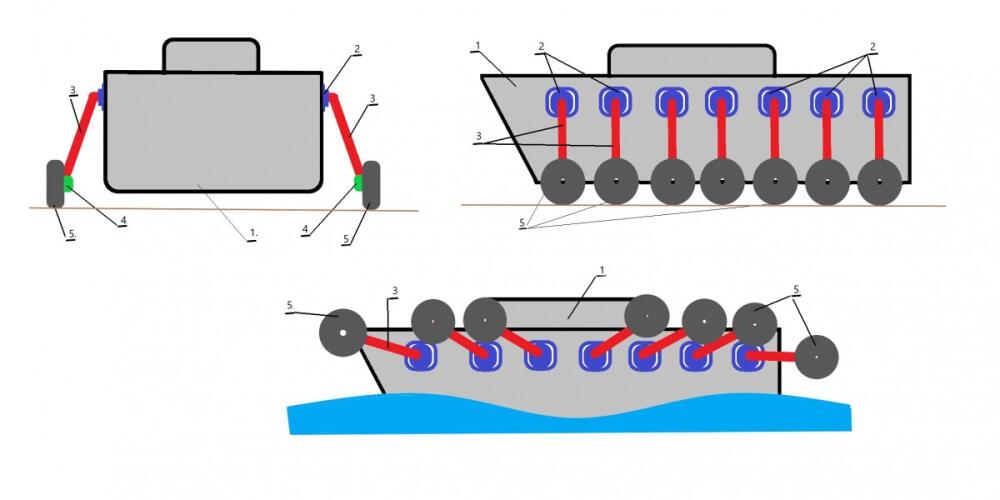
Boats are intended for navigation, but sometimes they must go out to dry. Smaller vessels are brought out to dry when they are repaired, while larger vessels are brought to the docks for water extraction for the same reasons, end you so leaving the boat dry.
If ships were sometimes able to go ashore and walk shorter distances, the functionality of the ships would increase significantly, and thus their value would increase.
Such is additional functionality could easily be added to smaller ships. It would be sufficient to place ship mounts on the sides of the ship with wheels that can rise when the ship is sailing, and bring down
when the ship it reaches the shore.
A number of such boat mounts with lifting and lowering mechanisms could be mounted on the sides of the ship by screws or welded.
On the sides of the ship (1) is mounted the joint of the carrier (2). The carrier joint (2) has an electric servo motor that lowers or raises the wheel carrier (3). This wheel carrier (3) is slightly slanted so as not to disturb each other when lifting and lowering.
The wheel carrier (3) at its end has a pivot joint (4) which has a servo motor which rotates the wheel (5) from left to right, which determines the direction of movement of the ship (1). On this pivot joint is a wheel axle. The wheel (5) is rotated by an electric motor located on the wheel axle itself.
When the ship is to go ashore, servo motors are started inside the joints of the carrier (2), which lower the wheel carriers (3) downwards. This places the wheels (5) below the level of the bottom of the ship itself (1) and, by means of an electric motor, the wheels begin to rotate. The ship (1) exits to the shore. When the ship goes ashore the movement is determined by the rotation of the pivot joint (4), which is performed by an electric servo motor located within this joint.
When a ship from the mainland needs to re-enter the water, it lowers on the wheels (5), and after entering the deep enough water the wheels rise again so as not to interfere with the movement of the ship through the water.
In order for the ship to have sufficient electricity within it, it must have a sufficiently strong electric generator that provides energy for all servo motors and for propelling the wheels (5) on land.
Boats with these types of ship carriers could have a very valuable application on many types of ships.
Most useful would be on military landing boats and smaller ships for unloading soldiers and armored vehicles on the banks of the seas and rivers.
They would also be very useful on riverboats so that they could cross the shallow parts of the river, or be able to go ashore.
Such smaller river warships, as they emerged ashore, could also serve as command points for ground forces advancing across flat terrain. Places of command like this could change their location all the time and make it harder to discover.
They could also serve as mobile hospitals moving in tandem with ground troops.
Such ships could be of great benefit when transporting large cargoes that are too large for road transport. Such cargoes could be transported by sea and river to the point nearest to the place of delivery or delivery. Once it arrives as close as possible, the ship goes ashore and transports the cargo through the meadows and fields to the point of delivery. This would greatly facilitate the transport of large machinery and equipment.
Other of my technical analyzes and innovations can be found in this book.
Tags
Featured articles